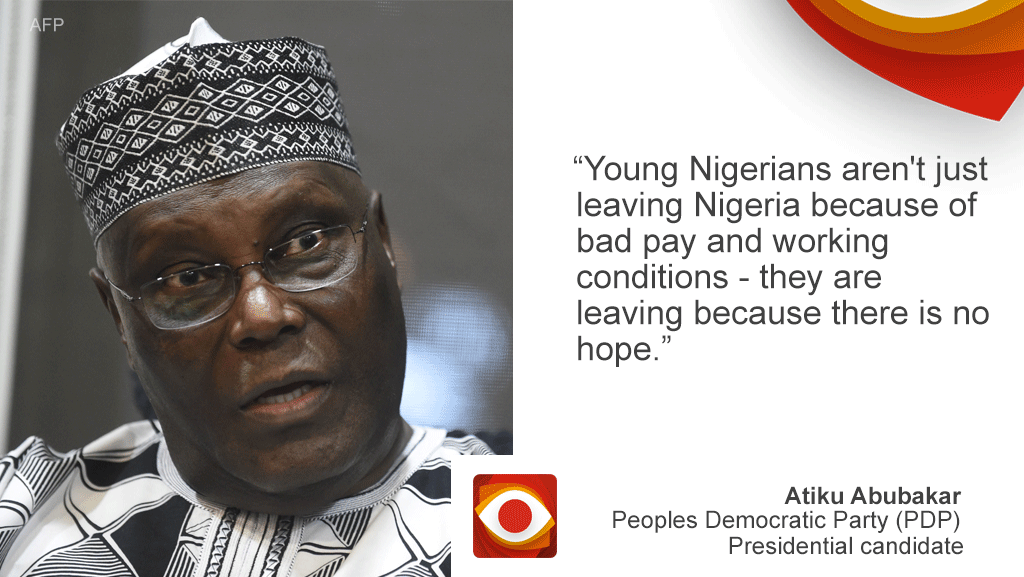Who’s leaving Africa’s largest economy?
The job market for young Nigerians is causing people to leave, says one of the leading contenders to become Nigeria’s next president.
“Young Nigerians aren’t just leaving Nigeria because of bad pay and working conditions – they are leaving because there is no hope,” opposition candidate Atiku Abubakar wrote on Twitter.
The flight of Nigeria’s trained professionals – especially doctors – is also a regular complaint.
What do we know know about the scale of people leaving Nigeria? Does the perception stand up to the statistics?
The Libyan route
As one Nigerian news outlet wrote, the high rate of Nigerians leaving the country, legally and illegally, has hit worrying levels.
Many of the migrants taking the central Mediterranean route into Europe come from Nigeria – frequently by boat from the coast of Libya to Italy.
In 2016, almost 40,000 Nigerians arrived in Italy, more than any other nationality. About 18,000 made the trip in 2017.
But the latest data shows that there has been a significant decline. Just 1,250 Nigerians arrived in Italy by sea in 2018.
This fall reflects the wider trend – fewer migrants crossed the Mediterranean last year.
The UN says that routes used by human traffickers are constantly changing and are dependent on a number of factors, but the drop in numbers reaching Italy is attributed mainly to closer co-operation with the Libyan coastguard.
And this closer monitoring of Libya’s coast has made illegal crossings much harder.
Huge risks
Testimony from those coming back to Nigeria after failed attempts bears this out, says Jorge Galindo of the International Organization for Migration (IOM).
Returning migrants, he says, are alerting people to the huge risks involved in the dangerous journey.
UN data suggests that Nigerians are not trying to get to Europe through Spain, which is now the main entry point for other migrants across the Mediterranean.
One reason might be that Nigeria has well-established links to people smugglers along the route between Libya and Italy. Those connections haven’t been forged along the path to Spain.
The migration figures, however, don’t include Nigerians who have left their homes but not managed to cross into Europe – many thousands are thought to be held in detention centres in Libya or along the way in other African countries.
About 11,500 Nigerians have returned home, assisted by the IOM, since 2017.
Out of this scheme, a pattern has emerged revealing from where in Nigeria the migrants have started their journeys.
The IOM says about half the total are from the southern Edo state – with a further quarter from neighbouring Delta state.
Nigeria is a huge country with a large population, but this data suggests that the people migrating come from a relatively small area.
Why Edo?
Edo state is the most established base for people smugglers, says Esohe Aghatise, who runs the anti-trafficking organisation Iroko.
Some leave in search of economic opportunities but fall into the hands of traffickers, she says.
But many others, especially women and girls, she says, are trafficked against their will or at least without any idea of what they are getting themselves into.
“People with an idea of a better life in Europe, finish school, and are promised paradise.”
Is there a brain drain?
Many Nigerians with professional qualifications seek to travel abroad, applying for visas to do so legally.
There are also those planning to study abroad or join other family members already there.
Some will stay for long periods, others will return at the end of their contracts or studies.
There are no official government statistics available, so one way to look at legal migration is through the numbers undergoing medical assessments as a requirement for visa applications.
These are carried out by the IOM’s migration health assessment centres in Lagos and Abuja.
In 2018, there were 21,000 examinations – a higher figure than in previous years.
As for medical doctors leaving Nigeria and contributing to the country’s “brain drain, this is hard to quantify.
We do know that more Nigerian-trained doctors are now working in the UK, for example. About 5,300, according to the British General Medical Council. That’s the highest after India and Pakistan, and it’s been going up steadily since 2006.
The former president of the National Association of Resident Doctors told Africa Check that more doctors are migrating because of poor working conditions and low pay.
A final indicator for those leaving to work or study abroad is the number of visas granted to Nigerians.
From a low point in 2010, skilled worker visas to the UK have steadily increased – 620 issued in 2017.
However, the number of study visas, excluding short term study, has been declining.
The largest Nigerian diaspora is in the US, according to UN figures. That population roughly doubled between 2007 and 2017.
‘Not just one-way traffic
An upside to migration are the remittances feeding back into the Nigerian economy.
Nigeria received $22bn in remittances in 2017, the 5th highest in the world, according to the World Bank.
It’s more difficult to get exact figures for people moving to Nigeria because there is free movement of people in the Economic Community of West African States (Ecowas) region.
The total number of migrants in Nigeria is estimated at 1.2 million, most of them coming from Benin, Ghana and Mali, according to the UN.
Read more from Reality Check
Send us your questions
Follow us on Twitter
Source: Read Full Article



